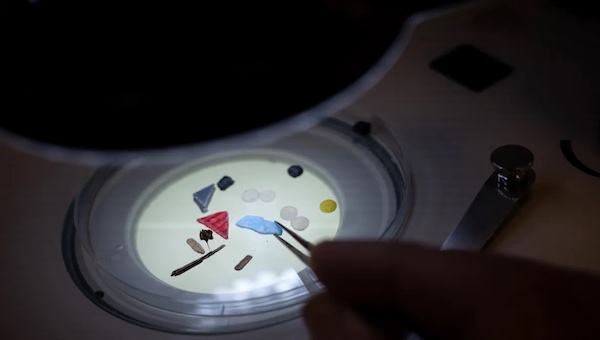
Professor Richard Thompson, director of the Marine Institute of Plymouth, analyses nurdles and other microplastics in a laboratory at the University of Plymouth in southwestern England. [Ben Stansall/AFP]
MILLIONS OF PLASTIC PELLETS FLOODING BEACHES ON ENGLISH COAST
BY: STAFF WRITER AL JAZEERAORIGINAL SITE: AL JAZEERA
TOPICS
Activism
AI
Belief
Big Pharma
Conspiracy
Cult
Culture
Economy
Education
Entertainment
Environment
Faith
Global
Government
Health
Hi Tech
Leadership
Politics
Prophecy
Science
Security
Social Climate
Universe
War
‘It does not disappear’: Activists remove non-biodegradable microplastics from a Cornwall beach. On an early spring afternoon, Tregantle Beach is bathed in a dazzling light reminiscent of a painting by British landscape artist JMW Turner as sea, sky and sun merge. “It’s beautiful, right? But look at your feet,” says Rob Arnold, 65, an environmental activist and artist, crouching down to pick tiny plastic balls out of the Cornwall sand.
The bits of plastic are the size of a lentil and are used by industry to manufacture plastic products. They are known as nurdles and are sometimes nicknamed “mermaids’ tears” because when spilled at industrial facilities, they can be swept into drains and out into the sea.
An estimated 11.5 trillion nurdles end up in the ocean each year, according to the UK charity Fauna & Flora International.
Once released into the natural environment, the nurdles circulate on ocean currents and often wash up on beaches and other shores.
They look like fish eggs, so birds and other sea life eat the pellets, which also absorb toxic pollutants, adversely affecting the entire food chain, Arnold says.
He is among about 10 people taking part in a cleanup on the beach in southwestern England’s Cornwall region, using a device he invented made from a plastic basin, a large grid and a set of tubes.
“It separates plastic waste from natural waste and sand, thanks to a filtering and water floating system,” the former engineer says.
He then uses the collected nurdles and other microplastics – tiny bits of plastic that have broken off larger pieces – in artworks.
Jed Louis, 58, wearing a khaki hoodie bearing the name of the local beach cleanup association, says several factors add to the beach’s vulnerability.
“This beach is particularly polluted because of its geographical location, the sea currents that affect it and its very open shape,” he says.
“In autumn and winter, we find the most microplastics because of the weather,” Louis says. “Storms, thunderstorms and winds – it brings them to the surface.
“Unfortunately the plastic remains, it does not disappear.”
Another volunteer Claire Wallerstein, 53, says the work is a bit like doing archaeology.
“If you dig in the sand, you’ll find different layers of plastic,” she says.
Some of the nurdles go to Arnold for his artistic creations while others are used to raise awareness in schools.
The rest, which cannot be recycled, end up in the rubbish and are incinerated.
After three hours, the volunteers have cleaned just a few square metres of the beach.
Arnold looks at his loot – a large tarp filled with nurdles and other microplastics.
Once dried and sorted, he can add them to the 20 million nurdles he has collected over six years. He stores them in a friend’s garage.
Arnold’s most notable work using the nurdles is a 1.7-metre (5.5-foot) sculpture, similar to the Moai statues of Easter Island.
The work is on display at the National Maritime Museum Cornwall in the coastal town of Falmouth under the title A Lesson from History.
“It’s a metaphor to what we are doing here to our planet Earth,” Arnold says. “We are polluting our planet, using its resources. If we destroy it, we have nowhere to go. This is our only home.”
For his next creation, he wants to mould the tiny plastic pellets into a meteorite headed towards Earth in a nod to the one that caused the extinction of the dinosaurs.
After cleaning up the beach and packing his nurdle-filled bags away, Arnold looks disillusioned.
“Sometimes I think about throwing all my bags of nurdles into the river from a bridge,” he says. “It would be so shocking that maybe, finally, people would realise.”

Volunteers take part in a beach cleanup that collects nurdles and other plastic waste on Tregantle Beach at Whitesand Bay near Freathy, England. [Ben Stansall/AFP]

A volunteer shows nurdles collected during the beach cleanup. About 11.5 trillion nurdles end up in the ocean every year, according to the UK group Fauna & Flora International. [Ben Stansall/AFP]

A volunteer pours microplastics onto a tarp. Once in nature, these pollutants circulate in the ocean and often wash up on beaches. [Ben Stansall/AFP]

A bag full of waste picked up during a beach cleanup. [Ben Stansall/AFP]

Nurdles are usually transparent and about the size of a lentil. Factories use them to make larger plastic objects, but like crude oil, they can easily escape during transport and are persistent pollutants, absorbing other pollutants as well. [Ben Stansall/AFP]

Environmental activists Jed Louis, right, and artist Rob Arnold carry a machine used to filter microplastics from natural waste. Arnold, who's also an engineer, invented the device to more efficiently remove nurdles from beaches. [Ben Stansall/AFP]

Arnold works on a sculpture called A Lesson from History, which he created in 2017 from nurdles and other microplastics collected from beaches. It is inspired by the Moai heads on Easter Island and is on display at the National Maritime Museum Cornwall. [Ben Stansall/AFP]
